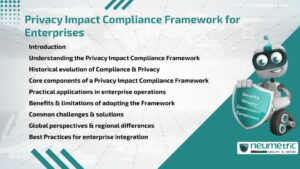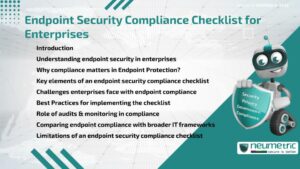Table of Contents
ToggleIntroduction
A Privacy Impact Compliance Framework is an essential structure for enterprises aiming to safeguard Sensitive Data, align with Legal standards & maintain Trust with Stakeholders. It provides guidelines for identifying Risks, conducting Assessments & establishing Controls to ensure Compliance with Data Protection regulations such as the General Data Protection Regulation [GDPR], the Health Insurance Portability & Accountability Act [HIPAA] & other regional laws. By applying this Framework, enterprises can minimise breaches, streamline Audits & create Accountability in handling Personal Information.
This article explores the Privacy Impact Compliance Framework in depth, covering its historical background, practical implementation, advantages & limitations. It also examines challenges enterprises often face, along with global perspectives & Best Practices for successful integration.
Understanding the Privacy Impact Compliance Framework
The Privacy Impact Compliance Framework is designed to help Organisations systematically assess the Impact of their activities on Personal Data. It involves processes such as Data Mapping, Risk identification & Compliance evaluation. Similar to a building’s blueprint, the Framework provides structure & clarity, ensuring every aspect of Privacy protection is accounted for.
Enterprises use it not only to meet Regulatory requirements but also to establish transparent Communication with Customers about how their information is used. A strong Framework helps enterprises avoid penalties & build long-term credibility.
Historical evolution of Compliance & Privacy
The roots of Privacy frameworks trace back to early Data Protection acts in Europe during the 1970s. These initial laws emphasised individual rights to data access & correction. Over time, the scope expanded, especially with the rise of the internet & digital data sharing. The GDPR, enacted in 2018, set a global benchmark by mandating Privacy Impact Assessments for high-Risk data processing.
This historical progression reflects a shift from voluntary practices to enforced Accountability. Enterprises now face increasing scrutiny to prove Compliance & adopt systematic frameworks.
Core components of a Privacy Impact Compliance Framework
A robust Privacy Impact Compliance Framework typically includes:
- Governance structure: Defines Accountability, Roles & Responsibilities.
- Data inventory: Catalogues Personal Data assets & processing activities.
- Risk Assessment: Identifies Threats to Confidentiality, Integrity & Availability.
- Mitigation measures: Establishes safeguards such as Encryption or Access Controls.
- Continuous Monitoring: Ensures regular updates as Laws & Risks evolve.
Together, these components create a cycle of Assessment, Action & Improvement.
Practical applications in enterprise operations
Enterprises apply the Framework in diverse contexts, from onboarding new technologies to managing Third Party Vendors. For instance, when deploying a new cloud service, the Framework guides teams in analysing data flows, assessing Third Party Compliance & Documenting safeguards.
It also supports internal Audits, helps streamline communication with Regulators & reduces the complexity of Cross-border Data Transfers. By embedding the Framework into daily operations, enterprises achieve consistency in protecting Personal Data.
Benefits & limitations of adopting the Framework
The advantages of using a Privacy Impact Compliance Framework include reduced Legal Risks, improved Customer Trust & Operational efficiency. It promotes a culture of Accountability, ensuring Employees understand their role in protecting data.
However, challenges exist. The Framework can be resource-intensive, requiring dedicated teams, ongoing training & significant investment. Smaller enterprises may find it difficult to implement without external support. Additionally, frameworks must be adapted to local regulations, which can complicate global operations.
Common challenges & solutions
Enterprises often encounter barriers such as lack of awareness, fragmented data systems or resistance to change. Solutions include:
- Conducting Training sessions to raise awareness.
- Implementing centralised data Governance tools.
- Engaging Stakeholders early in the process.
These measures help overcome operational & cultural hurdles, making Compliance frameworks sustainable.
Global perspectives & regional differences
While the GDPR influences many regions, local laws shape unique requirements. For example, the California Consumer Privacy Act [CCPA] emphasises Consumer Rights to opt out of data sharing, while Canada’s Personal Information Protection & Electronic Documents Act [PIPEDA] focuses on Consent & Accountability.
Enterprises operating globally must tailor their Privacy Impact Compliance Framework to align with these diverse legal landscapes. A one-size-fits-all approach rarely succeeds; regional customisation is essential.
Best Practices for enterprise integration
Successful adoption of the Privacy Impact Compliance Framework involves several Best Practices:
- Align the Framework with enterprise strategy & goals.
- Involve legal, technical & operational teams from the outset.
- Automate routine Assessments with Compliance software.
- Regularly review & update Procedures in response to new Threats.
- Document decisions thoroughly for Transparency.
By embedding these practices, enterprises can maximise the effectiveness of their Framework.
Conclusion
The Privacy Impact Compliance Framework offers enterprises a structured approach to managing Privacy Risks, meeting Regulatory demands & building Trust with Customers. While challenges such as resource requirements exist, the long-term benefits outweigh the costs, making it a critical part of modern enterprise operations.
Takeaways
- A Privacy Impact Compliance Framework ensures Compliance & Accountability.
- Historical evolution shows the growing importance of Privacy protections.
- Core components include Governance, Risk Assessments & Monitoring.
- Challenges can be mitigated with training, tools & Stakeholder engagement.
- Global enterprises must adapt frameworks to local regulations.
FAQ
What is a Privacy Impact Compliance Framework?
It is a structured approach enterprises use to assess Risks & ensure Compliance with Data Protection laws.
Why do enterprises need a Privacy Impact Compliance Framework?
Enterprises need it to reduce Risks, comply with Regulations & build Trust with Customers.
How does it differ from a general Privacy policy?
A Privacy policy explains practices to the public, while the Framework provides internal structures for managing Compliance.
What laws require Privacy Impact Compliance frameworks?
The GDPR, HIPAA & other regional laws often require or strongly recommend such frameworks.
Can small enterprises adopt a Privacy Impact Compliance Framework?
Yes, though they may need simplified versions or external consultants due to resource constraints.
What challenges arise in implementing the Framework?
Common challenges include lack of awareness, fragmented systems & high costs.
How often should a Privacy Impact Compliance Framework be updated?
It should be updated regularly, especially when regulations change or new technologies are adopted.
Need help for Security, Privacy, Governance & VAPT?
Neumetric provides organisations the necessary help to achieve their Cybersecurity, Compliance, Governance, Privacy, Certifications & Pentesting needs.
Organisations & Businesses, specifically those which provide SaaS & AI Solutions in the Fintech, BFSI & other regulated sectors, usually need a Cybersecurity Partner for meeting & maintaining the ongoing Security & Privacy needs & requirements of their Enterprise Clients & Privacy conscious Customers.
SOC 2, ISO 27001, ISO 42001, NIST, HIPAA, HECVAT, EU GDPR are some of the Frameworks that are served by Fusion – a SaaS, multimodular, multitenant, centralised, automated, Cybersecurity & Compliance Management system.
Neumetric also provides Expert Services for technical security which covers VAPT for Web Applications, APIs, iOS & Android Mobile Apps, Security Testing for AWS & other Cloud Environments & Cloud Infrastructure & other similar scopes.
Reach out to us by Email or filling out the Contact Form…





